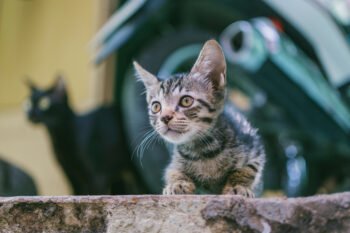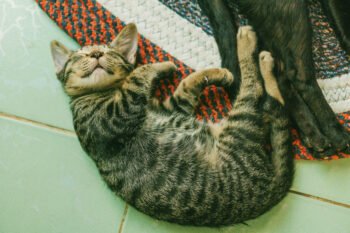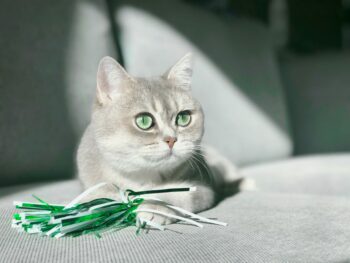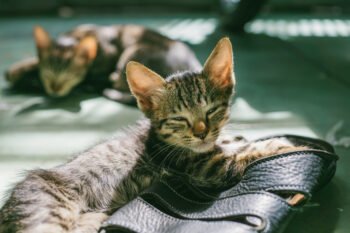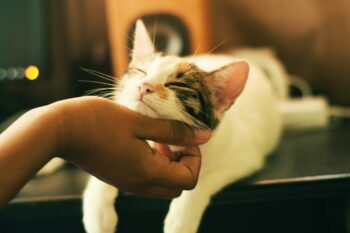Karen Thomas trains and lives with the Friskies Cat Team, and, since 1996, has been taking them to cat shows and exhibitions all over the country to entertain and to teach audiences about feline training. Thomas is also a Hollywood animal trainer, working for more than 12 years with cats for Critters of Cinema. You’ve seen her cats in television shows, movies, still photography shoots, music videos, and commercials, including the Fancy Feast and “Got Milk?” ads, the movies Stuart Little and Ed TV, and television shows Star Trek: the Next Generation and Felicity.
The Daily Cat: How did you get into this type of work?
Karen Thomas: I have a degree in zoology and worked in a zoo for two years as a volunteer zookeeper. I started twelve and a half years ago with Critters of Cinema because I wanted to get more training experience. I thought I was going to be working with lions and tigers and bears, but I really clicked with training the housecats. It’s actually very similar to training an exotic animal in that they want the self-gratification and a lot of positive reinforcement, only I get to keep all my fingers and toes.
I’ve noticed clicker training is the main way you train cats in the Friskies Cat Team. Why have you chosen this technique?
We have found, training all types of animals for the film industry, that clicker training seems to be a more efficient, more effective, more exacting way of training animals. When you use a clicker, the animals just seem to respond so much quicker and learn new behaviors a lot more easily.
Where do you find these cats, and what do you look for in a cat?
We have rescued many of our cats from shelters around the country, and we’ve also purchased cats from breeders. Generally, what we look for in film work is a cat who is photogenic, and also we need cats who we can double, because for most film projects, even the Friskies and Fancy Feast commercials, it takes more than one cat to finish a project. You’ll notice on television that you’ll generally see a red tabby, a brown tabby, a black cat, a white cat, because these cats are more easily doubled. We also have friends in Hollywood who are animal colorists, and they specialize in using all natural colors to help match kitties when we need to.
We also need an outgoing personality. Not every cat is going adjust to travel and audiences, so, after a certain period of time if the cat is not comfortable with that, we will place him in a good home.
The Friskies cats perform several times a day, and between shows they are on display in their beautiful Plexiglas condo. How do you keep them from getting too stressed?
We don’t rush our cats into it. You can train your own cat at home within a matter of weeks or months to do all kinds of neat behaviors. However, for what we do, we take about a year to teach our cats to travel in a car, be in an airplane, and stay in hotel rooms, and be comfortable doing so. We also have to get them used to sounds that occur within a convention center, such as applause and loudspeakers, and teach them to know that it’s safe, that they’re not going to be harmed.
I’m not going to say that they don’t get tired, any more than you or I do when we go to work, because they absolutely do. Cats sleep about 18 hours a day, and they’re pretty much awake most of that day. They do crash when we get back to the hotel room. But they learn to love the applause because they just know they’re going to get attention and a reward. That’s our optimal goal-to make sure they’re having fun-as well as teaching audiences about cats.
What’s the hardest thing you ever had to teach a cat to do?
Usually, the hardest thing to teach are natural behaviors on cue. These aren’t things that people at home would necessarily be training, but when you’re watching a movie or a commercial, oftentimes you’ll see the cat sleeping on top of a clothes dryer or kneading his little paws on a pillow, These are behaviors a cat does every day. But to tell a cat, “OK, lie down, curl up, put your head down, close your eyes and stay” is a tough behavior to teach, especially when you’ve got an entire film crew watching.
What do you tell people who say, “Oh, you just can’t train a cat”?
So many people don’t believe you can train a cat because they mistake their independence for being untrainable. They’re used to dogs, who want to do anything to make you happy because they’re pack animals and they need that for their own self-assurance. These people just have to think more like a cat.
A cat loves you, but they don’t necessarily feel that need to make sure that you’re happy. They’ll come and comfort you when you’re upset, but they’re basically looking for self-gratification most of the time-which is why we love them. You have to tap into that when you train your cat. Therefore, it’s very important to use positive reinforcement. Otherwise, your cat is not going to enjoy being trained at all. So using a food reward or a pat on the head-they definitely want that.
You have to tap into your cat’s style, too. Not every cat is going to do every behavior. See what your cat enjoys doing the most. Does he like to retrieve? Does he bring you back toys to throw again? If he doesn’t, you’re never going to teach him to retrieve. If your cat likes to play more with his paws to catch his toys, then use that. Use his natural behaviors and train within that personality, and that will make it more positive for both of you.
Is that one of the reasons why you need several cats to perform the same role in a film?
Exactly. Oftentimes within our team of, let’s say, red tabbies, we have what we call our “plop cat,” which is the cat who will just plop anywhere and just lie there. Then we have some cats (and we all have had them at one time or another) who don’t sit still, ever. They’re very active, and they have a real high food drive as well, and they’ll just do anything for a treat. They’re the ones who we will train to run from one place to another, jump over the couch, and do behaviors like that.
So you use these cats for different shots in a film, and each one does what he’s good at?
Exactly. In the movie Stuart Little, there were six cats who portrayed Snowbell the cat.
You train cats for a living, but why should people train their cats at home?
It’s really a way for you to bond with your cat and spend some quality time together. We get so busy in our day-to-day life-we just drop food on the floor for our pets, run to work and come home; we really don’t pay enough attention to our pets. If you just spend five or 10 minutes a day training your cat, setting aside special time together, it makes a big difference for you and your cat, and it keeps your cat mentally healthy too.
So many of us have indoor cats today, too, because it does increase their life expectancy, but they’re not outside hunting and doing other activities. And when you’re at work, they’re sitting at home and sleeping the whole time, not using their minds. That’s why you need to play, interact, train and do things to keep your cats mentally active, so they live longer and healthier lives.

